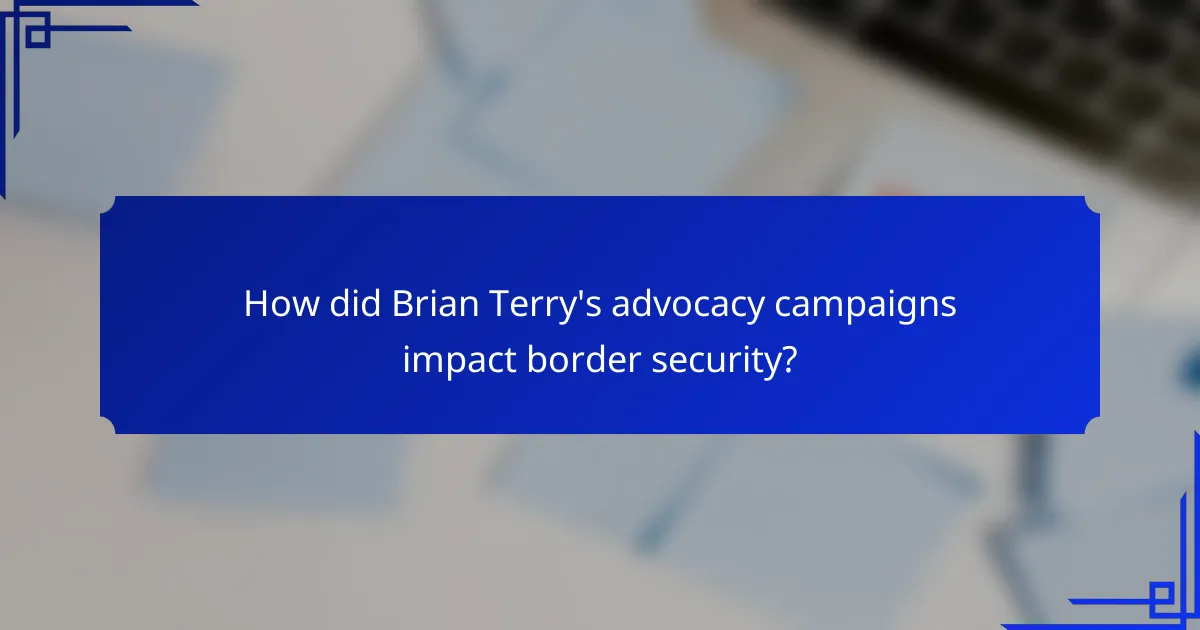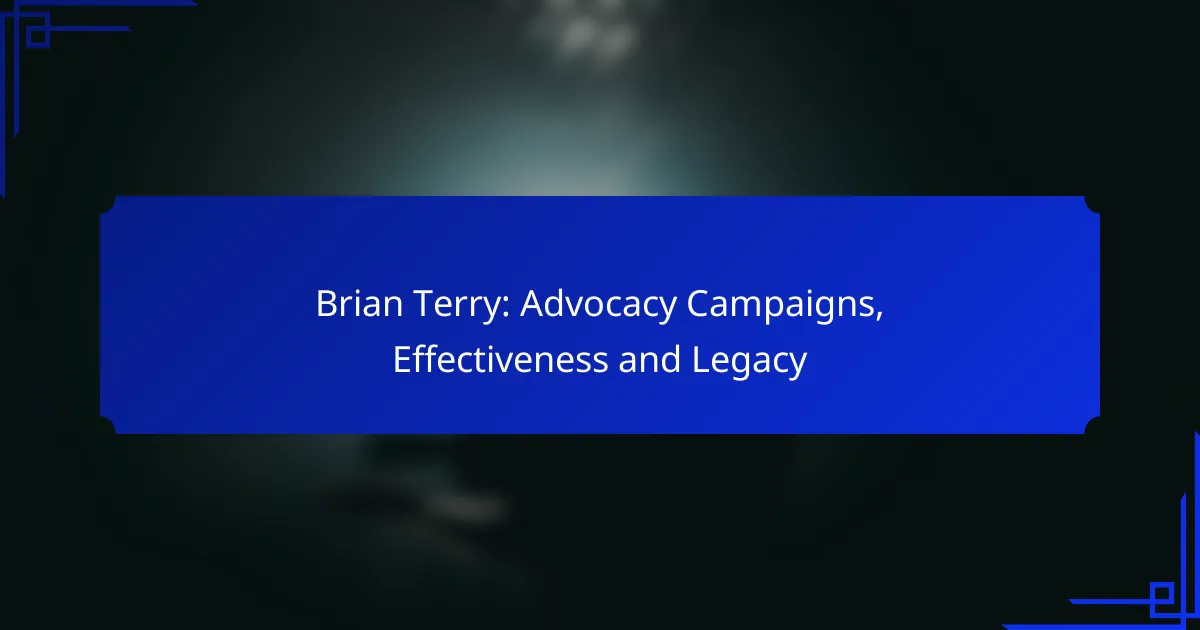Brian Terry’s advocacy campaigns played a pivotal role in shaping the discourse around border security and immigration enforcement. By employing grassroots organizing, media engagement, and coalition building, he effectively raised awareness and prompted significant policy discussions, ultimately fostering a more informed public dialogue on these critical issues.

How did Brian Terry’s advocacy campaigns impact border security?
Brian Terry’s advocacy campaigns significantly influenced border security by raising public awareness, prompting policy changes, and fostering community engagement. His efforts highlighted critical issues surrounding border safety and immigration enforcement, leading to a more informed public discourse.
Increased awareness of border issues
Terry’s campaigns brought national attention to the complexities of border security, particularly the dangers faced by law enforcement and civilians alike. By sharing personal stories and statistics, he helped the public understand the stakes involved in border enforcement and immigration policies.
Through various media outlets and public forums, Terry’s advocacy highlighted the risks of illegal crossings and the impact of drug trafficking. This increased visibility led to a more engaged citizenry, prompting discussions about the need for comprehensive border reform.
Influenced policy changes
Brian Terry’s advocacy efforts contributed to significant policy discussions at local and national levels. His tragic death underscored the urgent need for reforms in border security practices, leading to legislative proposals aimed at enhancing safety measures for border agents.
As a result of heightened awareness and public pressure, some policies were adjusted to improve coordination between federal and local law enforcement agencies. These changes aimed to better allocate resources and enhance the effectiveness of border security operations.
Mobilized community support
Terry’s campaigns galvanized community support for border security initiatives, encouraging local groups to advocate for safer practices. His story resonated with many, leading to increased volunteerism and donations for organizations focused on border safety and immigration reform.
Community events, rallies, and educational programs emerged as a direct response to Terry’s advocacy, fostering a sense of solidarity among those concerned about border issues. This mobilization helped create a more informed and active citizenry, pushing for continued dialogue and action on border security matters.

What strategies were used in Brian Terry’s advocacy?
Brian Terry’s advocacy utilized various strategies to effectively raise awareness and drive change regarding border security and immigration policies. Key approaches included grassroots organizing, media engagement, and coalition building, each playing a significant role in amplifying his message and mobilizing support.
Grassroots organizing
Grassroots organizing was central to Brian Terry’s advocacy efforts, focusing on mobilizing local communities to take action. This approach involved training volunteers to engage with their neighbors, fostering a sense of ownership and urgency around the issues of border security and immigration reform.
Effective grassroots campaigns often include door-to-door canvassing, community meetings, and local events to build momentum. Engaging constituents in their own communities helps personalize the issues, making them more relatable and urgent.
Media engagement
Media engagement was crucial for amplifying Brian Terry’s advocacy message. By leveraging traditional media outlets, social media platforms, and public speaking opportunities, his campaign reached a broader audience and raised awareness about the challenges faced at the border.
Strategically timed press releases, interviews, and opinion pieces helped shape public discourse. Utilizing social media allowed for real-time interaction and mobilization, enabling supporters to share information quickly and effectively.
Coalition building
Coalition building involved forming alliances with various organizations and stakeholders to strengthen advocacy efforts. By collaborating with groups that shared similar goals, Brian Terry’s campaign was able to pool resources, share expertise, and expand its reach.
Successful coalitions often include non-profits, community organizations, and advocacy groups, all working together to create a unified front. This collective approach not only enhances credibility but also increases the potential for impactful change through combined efforts and shared messaging.

What was the effectiveness of Brian Terry’s campaigns?
Brian Terry’s advocacy campaigns were notably effective in raising awareness about border security and immigration issues, leading to significant legislative discussions and public engagement. His efforts catalyzed changes in policy and public opinion, highlighting the complexities of these topics in the U.S.
Legislative outcomes
Terry’s campaigns influenced various legislative outcomes, particularly in the realm of border security and immigration reform. His advocacy contributed to heightened scrutiny of existing policies, prompting lawmakers to consider reforms aimed at improving border safety and accountability in law enforcement practices.
For instance, discussions around the need for comprehensive immigration reform gained momentum, with some proposals focusing on enhancing border security measures and addressing the challenges faced by law enforcement agencies. These legislative efforts often reflected the urgency of the issues raised by Terry’s campaigns.
Public opinion shifts
Brian Terry’s advocacy led to noticeable shifts in public opinion regarding immigration and border security. His tragic story resonated with many Americans, fostering a greater understanding of the risks involved in border enforcement and the complexities of immigration policy.
Surveys indicated that public support for stricter border security measures increased following his campaigns. This shift was crucial in shaping the narrative around immigration, as more individuals began to advocate for balanced approaches that consider both security and humanitarian aspects.
Long-term advocacy frameworks
The legacy of Brian Terry’s campaigns established long-term advocacy frameworks that continue to influence discussions on border security and immigration. Organizations dedicated to these issues have adopted strategies that emphasize accountability, transparency, and community engagement, inspired by Terry’s story.
These frameworks often include coalition-building among various stakeholders, including law enforcement, community groups, and policymakers. By fostering collaboration, advocates aim to create sustainable solutions that address both security concerns and the rights of individuals affected by immigration policies.

What is Brian Terry’s legacy in advocacy?
Brian Terry’s legacy in advocacy centers on his commitment to border security and the fight against illegal immigration, which has inspired many to engage in similar causes. His tragic death highlighted the need for reform and accountability in law enforcement and immigration policies, leaving a lasting impact on advocacy efforts across the United States.
Inspiration for future activists
Brian Terry’s story serves as a powerful motivator for future activists who seek to address issues related to border security and immigration reform. His dedication to these causes encourages individuals to take action, whether through grassroots organizing, public speaking, or policy advocacy.
Many activists cite Terry’s case as a turning point that galvanized public attention and spurred community engagement. This inspiration can lead to increased participation in advocacy campaigns and a greater willingness to confront complex issues.
Establishment of non-profits
In the wake of Brian Terry’s death, several non-profit organizations emerged to advocate for border security and immigration reform. These organizations focus on raising awareness, providing resources, and lobbying for legislative changes that reflect Terry’s ideals.
These non-profits often engage in community outreach, educational programs, and partnerships with other advocacy groups to amplify their message. By establishing a network of support, they aim to create a sustained impact on policy discussions surrounding immigration and border security.
Continued relevance of his causes
The causes championed by Brian Terry remain highly relevant in today’s political climate, as debates over immigration and border security continue to dominate public discourse. His legacy serves as a reminder of the human impact of these policies and the importance of accountability in law enforcement.
Advocacy efforts inspired by Terry’s story are crucial in shaping future legislation and public opinion. As new challenges arise, the principles he stood for continue to resonate, motivating ongoing discussions and actions aimed at reforming immigration practices in the United States.

How can advocates learn from Brian Terry’s approach?
Advocates can learn from Brian Terry’s approach by focusing on personal narratives and leveraging social media to amplify their messages. These strategies can create a deeper connection with audiences and enhance the effectiveness of advocacy campaigns.
Emphasizing personal stories
Personal stories are powerful tools in advocacy as they humanize issues and resonate emotionally with audiences. By sharing individual experiences, advocates can illustrate the real-world impact of policies or social issues, making them more relatable and urgent.
For instance, an advocate might share a compelling story about how immigration policies affected their family, which can evoke empathy and spur action among listeners. This method often leads to increased engagement and support for the cause.
Utilizing social media effectively
Social media platforms are essential for modern advocacy, allowing for rapid dissemination of messages and fostering community engagement. Advocates should focus on creating shareable content that highlights their cause, using visuals and concise messaging to capture attention.
To maximize impact, advocates can utilize hashtags, collaborate with influencers, and engage in conversations around trending topics. Regularly updating followers with news and personal stories can help maintain momentum and build a loyal supporter base.
